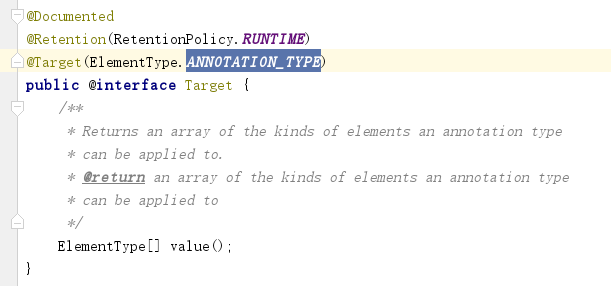java元注解 @Target注解用法
@Target:
@Target说明了Annotation所修饰的对象范围:Annotation可被用于 packages、types(类、接口、枚举、Annotation类型)、类型成员(方法、构造方法、成员变量、枚举值)、方法参数和本地变量(如循环变量、catch参数)。在Annotation类型的声明中使用了target可更加明晰其修饰的目标。
作用:用于描述注解的使用范围(即:被描述的注解可以用在什么地方)

取值(ElementType)有
1 2 3 4 5 6 7 8 9 10 11 12 13 14 15 16 17 18 19 20 21 22 23 24 25 26 27 28 29 30 31 32 33 34 35 36 | public enum ElementType { /**用于描述类、接口(包括注解类型) 或enum声明 Class, interface (including annotation type), or enum declaration */ TYPE, /** 用于描述域 Field declaration (includes enum constants) */ FIELD, /**用于描述方法 Method declaration */ METHOD, /**用于描述参数 Formal parameter declaration */ PARAMETER, /**用于描述构造器 Constructor declaration */ CONSTRUCTOR, /**用于描述局部变量 Local variable declaration */ LOCAL_VARIABLE, /** Annotation type declaration */ ANNOTATION_TYPE, /**用于描述包 Package declaration */ PACKAGE, /** * 用来标注类型参数 Type parameter declaration * @since 1.8 */ TYPE_PARAMETER, /** *能标注任何类型名称 Use of a type * @since 1.8 */ TYPE_USE |
1 | ElementType.TYPE_PARAMETER(Type parameter declaration) 用来标注类型参数, 栗子如下: |
1 2 3 4 5 6 7 8 9 10 11 12 | @Target(ElementType.TYPE_PARAMETER)@Retention(RetentionPolicy.RUNTIME)public @interface TypeParameterAnnotation { }// 如下是该注解的使用例子public class TypeParameterClass<@TypeParameterAnnotation T> { public <@TypeParameterAnnotation U> T foo(T t) { return null; } } |
ElementType.TYPE_USE(Use of a type) 能标注任何类型名称,包括上面这个(ElementType.TYPE_PARAMETER的),栗子如下:
1 2 3 4 5 6 7 8 9 10 11 12 13 14 15 16 17 18 19 20 21 22 23 24 25 | public class TestTypeUse { @Target(ElementType.TYPE_USE) @Retention(RetentionPolicy.RUNTIME) public @interface TypeUseAnnotation { } public static @TypeUseAnnotation class TypeUseClass<@TypeUseAnnotation T> extends @TypeUseAnnotation Object { public void foo(@TypeUseAnnotation T t) throws @TypeUseAnnotation Exception { } } // 如下注解的使用都是合法的 @SuppressWarnings({ "rawtypes", "unused", "resource" }) public static void main(String[] args) throws Exception { TypeUseClass<@TypeUseAnnotation String> typeUseClass = new @TypeUseAnnotation TypeUseClass<>(); typeUseClass.foo(""); List<@TypeUseAnnotation Comparable> list1 = new ArrayList<>(); List<? extends Comparable> list2 = new ArrayList<@TypeUseAnnotation Comparable>(); @TypeUseAnnotation String text = (@TypeUseAnnotation String)new Object(); java.util. @TypeUseAnnotation Scanner console = new java.util.@TypeUseAnnotation Scanner(System.in); }} |
分类:
Java






【推荐】国内首个AI IDE,深度理解中文开发场景,立即下载体验Trae
【推荐】编程新体验,更懂你的AI,立即体验豆包MarsCode编程助手
【推荐】抖音旗下AI助手豆包,你的智能百科全书,全免费不限次数
【推荐】轻量又高性能的 SSH 工具 IShell:AI 加持,快人一步
· 开发者必知的日志记录最佳实践
· SQL Server 2025 AI相关能力初探
· Linux系列:如何用 C#调用 C方法造成内存泄露
· AI与.NET技术实操系列(二):开始使用ML.NET
· 记一次.NET内存居高不下排查解决与启示
· 被坑几百块钱后,我竟然真的恢复了删除的微信聊天记录!
· 没有Manus邀请码?试试免邀请码的MGX或者开源的OpenManus吧
· 【自荐】一款简洁、开源的在线白板工具 Drawnix
· 园子的第一款AI主题卫衣上架——"HELLO! HOW CAN I ASSIST YOU TODAY
· Docker 太简单,K8s 太复杂?w7panel 让容器管理更轻松!